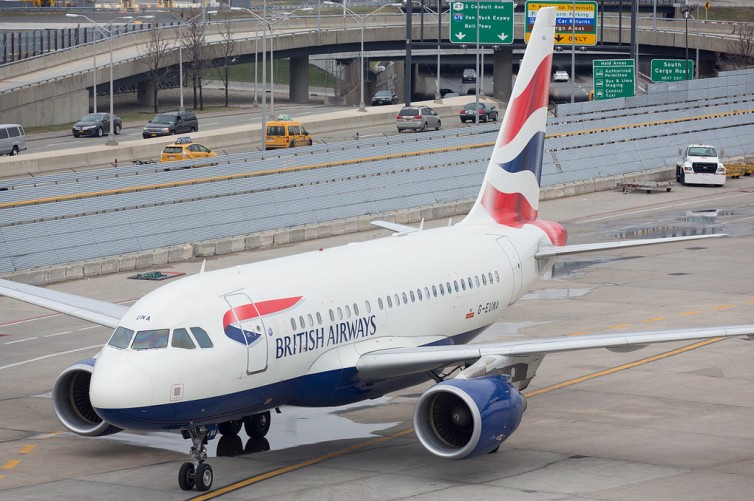
One of the British Airways Airbus A318s at JFK – Photo: Jeremy Dwyer Lindgren | JDLMultimedia
When it comes to long-haul flying, typically the bigger the aircraft the better. Whether it’s the Boeing 747 or Airbus A380, these are the aircraft typically associated with extreme luxury – private suites, on-board showers, and maybe even a fully stocked bar. Sometimes, though, smaller might actually be better. British Airways operates a pair of tiny Airbus A318s between New York JFK and London City Airport (LCY) with a business class-only configuration featuring only 32 seats (by comparison, Air France carries 131 passengers on their A318s). It sure is a strange (but great) way to fly. To give you a sense of just how small the A318 is, here are some numbers to help size it up: The Airbus A380 sports a total length of 238 feet with a 261-foot wingspan. The A318 is just 103 feet long with a wingspan of just under 112 feet.
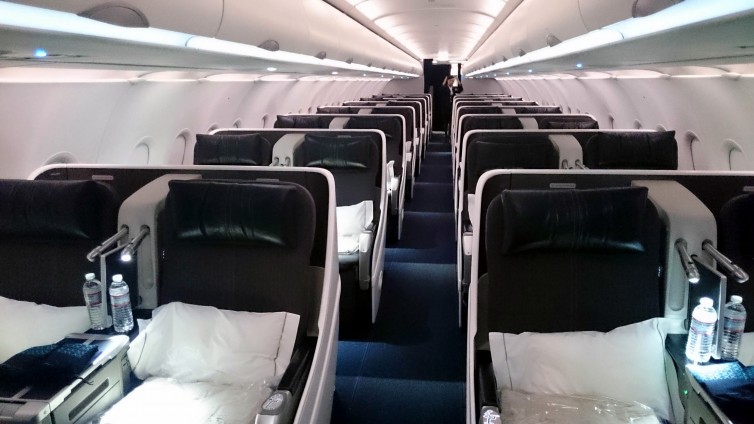
The British Airways A318 cabin only has 32 seats – Photo: Jason Rabinowitz
I was recently able to fly from JFK to LCY and experience what it’s like flying into London on the A318. Spoiler: It’s wonderful and actually quite a different experience. While the London to New York flight involves a stop in Shannon, Ireland for fuel, the reverse flight is non-stop.
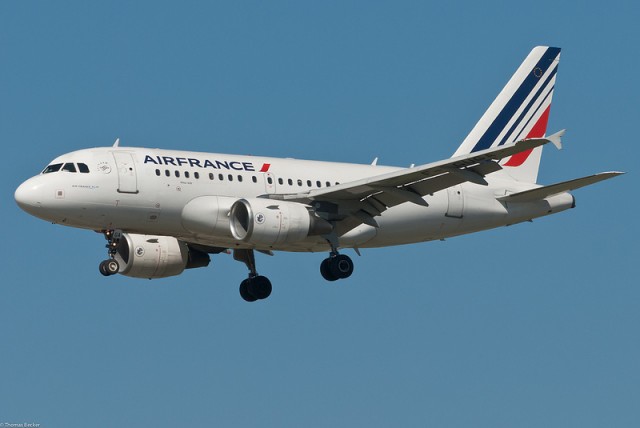
An Air France Airbus A318. The airline is the world’s largest operator of the A318. Photo: Thomas Becker
The last Airbus A318 operated by a North American airline has exited service. The A318, sometimes affectionately referred to as the “Babybus,” is the smallest member of the Airbus A320 family. Weighing nearly the same as its larger brother, the A319, and operating with the same crew requirements, the economics of operating the A318 in North America just didn’t make sense. The similarly-sized Boeing 737-600 has largely suffered the same fate (although WestJet still operates a fleet in Canada).
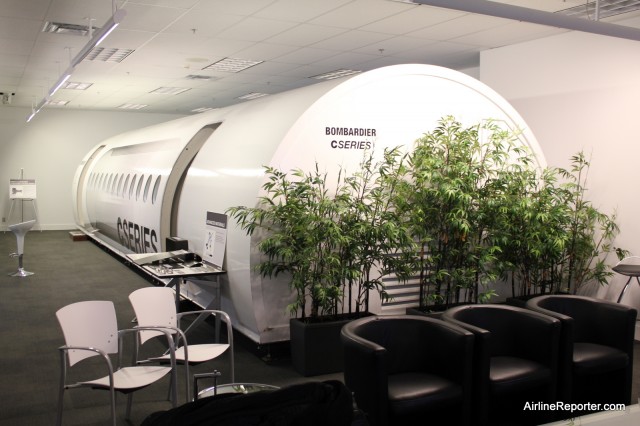
Bombardier's Cseries located in Montreal, Quebec -- tres bon!
After spending the day with Bombardier recently to learn about their new CSeries, the biggest thing I pulled away that you, the passenger will care the most about is SPACE — lots of it. This is the interior that many passengers have been begging for and they are finally going to get it. All the time , I hear people asking for wider seats, more room, etc. But really, what airline is going to take a Boeing 737 or Airbus A320 and go from six seats across to five? (hint: none). The CSeries is designed to provide that extra space that passengers want, but not the additional weight that costs the airlines more money. Bombardier has built enough width into their new CSeries to give passengers extra room, but not enough for airlines to fit in additional seats.
The cabin of the CSeries is set up in a 2-3 layout for economy and 2-2 layout for first class. Personally, I have always loved this layout on the DC-9/MD-80/Boeing 717 aircraft. If you are flying with someone, it gives you the chance for you two to sit together on the two side and not be bothered by a third person. A big downside of those older aircraft was the noise level in the back of the plane from the engines being rear mounted. That won’t be a problem with the CSeries, since the engines are wing-mounted.
Some readers on my Facebook pointed out that having a wider seat is not something new. Piedmont Airlines did it, but it surely has been a long while and really this comes from the design of the aircraft, not from an airline deciding to make the middle seat wider.
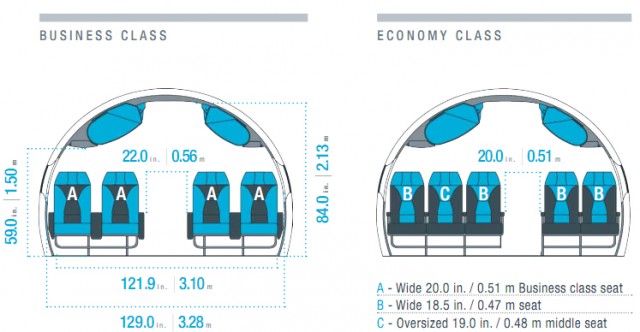
There is plenty of width in the new Bombardier CSeries. Image from Bombardier.
The interior is designed so that most economy seats have 18.5″ width — except the middle seat which is 19″. Now, this just blew my mind… the middle seat is actually 1/2″ wider than the other seats on the plane. How genius is that? Not only that, but a standard 18.5″ width for a short haul seat is great. Many airlines run wide-body, long haul flights with only 18″ or even 17″.
Now, I know what you are all thinking, “Yea right. Bombardier might design the aircraft with space, but airlines will find ways to use that space to fit in as many seats as possible.” Well, do not worry, that will not be the case. First off, there is about half a seat width (from an average aircraft) of extra space built into the plane. If you do the math and an airline puts the aisle to 18″, that would mean each seat would be 15.8″ and that just is not going to happen. Plus, the plane is designed to hold so many passengers with the emergency exits given, so even if an airline made impossibly thin seats, most of them would have to remain empty.
Although seat width will be pretty standard, airlines will have choice with what seat pitch they want to offer. The CSeries mock up in Montreal has the rows set up with different examples from 32″ to 28″. Let me say that at 6’1″, I really hope no airline opts for the 28″ seat pitch on any airplane — ever.
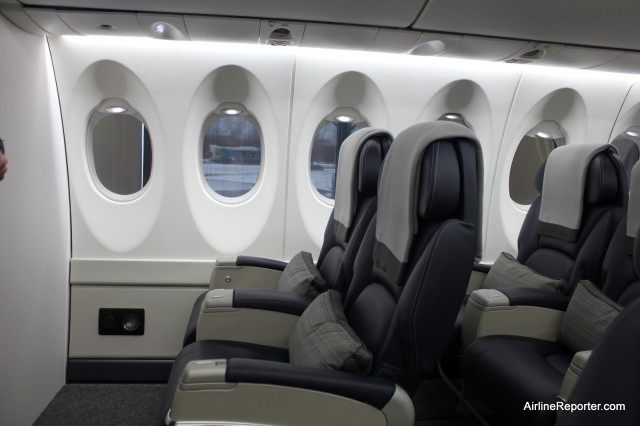
The windows are quite large on the new CSeries, providing more natural light and shoulder room.
The CSeries will sport larger windows than its competition, allowing more natural light and a bit more shoulder room. The CSeries will have windows measuring 11×16″, which are about the size you would find on a Boeing 777.
If you choose a window seat, rest assured, you will actually get a window. How annoying is it to get to your window seat and see a solid wall with no window? Bombardier designed the CSeries so that each row would have at least one window. Not only does this provide great spotting opportunities, it also allows more natural light into the cabin.
At this point, it appears that each window will have a traditional sun shade and not the electronic ones found on the 787 Dreamliner. The reason is this is a smaller aircraft, running shorter hops than the 787 and the extra cost really did not make sense. Like the Dreamliner, the CSeries will also have LED lighting that can change color based on what the airline customer might want.
The aircraft is set to compete directly with the Airbus A318 and A319, the Boeing 737-600 / 737-700, and the Embraer E-195. Bombardier is also hoping those airlines that operate DC-9s and MD-80 aircraft (I am talking to you American and Delta Air Lines) might want to update their fleet with the CSeries.
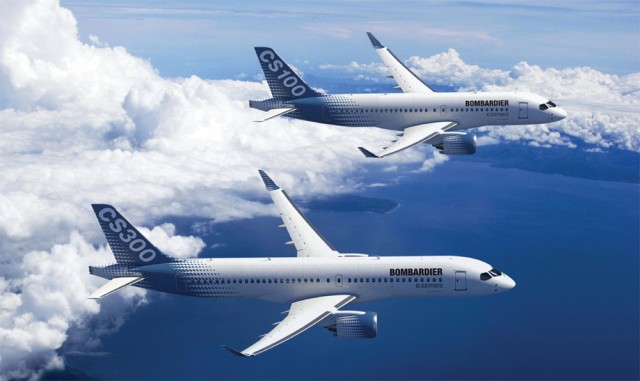
A look at the CSeries 100 and CSeries 300 in this computer mock up from Bombardier.
When designing the CSeries, Bombardier decided to use an aluminum alloy for the fuselage and composite wings. “For the fuselage we performed trade-off analyses, involving airlines in the process, between composite and advanced aluminum design options,” Sebastien Mullot, CSeries Program Director at Bombardier, explained to AirlineReporter.com. “It turned out that the weight gain in the composite option was not as important as in other composite parts (e.g wing) and airlines drew our attention to the fact that this weight gain might be offset by the additional costs that could be incurred on the maintenance side.”
Since the CSeries will be a high-cycle aircraft, there is a much higher chance that the aircraft will be damaged during normal operations. Currently, repairing composite aircraft requires special equipment and procedures, which would have increased operational costs and complexity for airlines. The aluminum alloy used on the CSeries is a aluminum-lithium hybrid that is lighter than traditional aluminum and still can be repaired easily. For now, it seemed to be a perfect fit for what the CSeries will be doing.
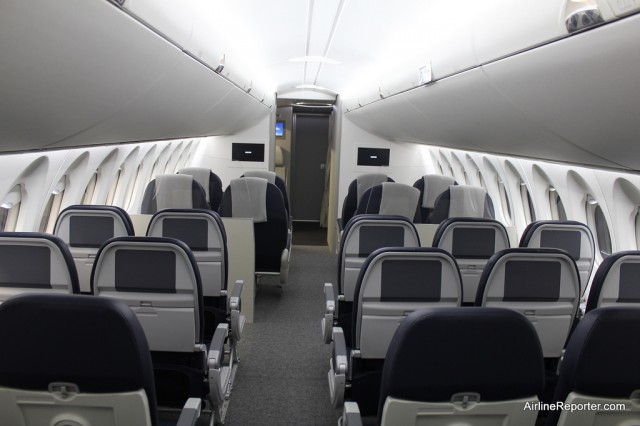
The mock up for the CSeries has different seat pitches for each row. You can see that some have fake entertainment screens as well.
Bombardier is confident that the CSeries will have its first flight before the end of the year. When I asked about potential delays, they stated that they had built-in time for potential delays and unlike other aircraft manufacturers, they have been outsourcing part of their aircraft production for a very long time and are well experienced. They have already been able to work out the kinks and problems from experiences learned with previous aircraft and have not seen the issues that other companies have (ie Boeing and Airbus).
The company hopes that the CSeries will be a complete package for airlines, passengers, crew and the environment. “In an challenging economic environment, airlines have been seeking to grow their average aircraft size in a race to improve their cost efficiency,” Mullot explained. “This aircraft will also be the only single-aisle aircraft to meet 21st century operating requirements: improving flight crew situational awareness, meeting new air traffic control needs and dramatically reducing airlines’ environmental footprint!”
One interesting fact is that we do not know who the launch customer for the CSeries will be. That customer has asked to remain secret and Bombardier is not talking. I am hoping it will be a game changer like Southwest, Ryanair or EasyJet who all operate single aircraft type, but it likely will not be that exciting.
OTHER CSERIES STUFF YOU MUST CHECK OUT:
* All 17 photos of the CSeries mockup in Montreal
* Video of the second mock up by Simpliflying







